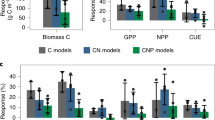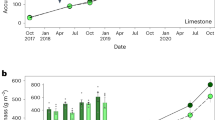Abstract
Rising atmospheric CO2 stimulates photosynthesis and productivity of forests, offsetting CO2 emissions1,2. Elevated CO2 experiments in temperate planted forests yielded ∼23% increases in productivity3 over the initial years. Whether similar CO2 stimulation occurs in mature evergreen broadleaved forests on low-phosphorus (P) soils is unknown, largely due to lack of experimental evidence4. This knowledge gap creates major uncertainties in future climate projections5,6 as a large part of the tropics is P-limited. Here, we increased atmospheric CO2 concentration in a mature broadleaved evergreen eucalypt forest for three years, in the first large-scale experiment on a P-limited site. We show that tree growth and other aboveground productivity components did not significantly increase in response to elevated CO2 in three years, despite a sustained 19% increase in leaf photosynthesis. Moreover, tree growth in ambient CO2 was strongly P-limited and increased by ∼35% with added phosphorus. The findings suggest that P availability may potentially constrain CO2-enhanced productivity in P-limited forests; hence, future atmospheric CO2 trajectories may be higher than predicted by some models. As a result, coupled climate–carbon models should incorporate both nitrogen and phosphorus limitations to vegetation productivity7 in estimating future carbon sinks.
This is a preview of subscription content, access via your institution
Access options
Access Nature and 54 other Nature Portfolio journals
Get Nature+, our best-value online-access subscription
$29.99 / 30 days
cancel any time
Subscribe to this journal
Receive 12 print issues and online access
$209.00 per year
only $17.42 per issue
Buy this article
- Purchase on Springer Link
- Instant access to full article PDF
Prices may be subject to local taxes which are calculated during checkout



Similar content being viewed by others
References
Bonan, G. B. Forests and climate change: forcings, feedbacks, and the climate benefits of forests. Science 320, 1444–1449 (2008).
Friedlingstein, P. et al. Persistent growth of CO2 emissions and implications for reaching targets. Nat. Geosci. 7, 709–715 (2014).
Norby, R. J. et al. Forest response to elevated CO2 is conserved across a broad range of productivity. Proc. Natl Acad. Sci. USA 102, 18052–18056 (2005).
Piao, S. L. et al. Evaluation of terrestrial carbon cycle models for their response to climate variability and to CO2 trends. Glob. Change Biol. 19, 2117–2132 (2013).
Cox, P. M. et al. Sensitivity of tropical carbon to climate change constrained by carbon dioxide variability. Nature 494, 341–344 (2013).
Schimel, D. et al. Effect of increasing CO2 on the terrestrial carbon cycle. Proc. Natl Acad. Sci. USA 112, 436–441 (2015).
Reed, S. C. et al. Incorporating phosphorus cycling into global modeling efforts: a worthwhile, tractable endeavor. New Phytol. 208, 324–329 (2015).
Friedlingstein, P. et al. Uncertainties in CMIP5 climate projections due to carbon cycle feedbacks. J. Clim. 27, 511–526 (2014).
Sitch, S. et al. Recent trends and drivers of regional sources and sinks of carbon dioxide. Biogeosciences 12, 653–679 (2015).
Arora, V. K. et al. Carbon-concentration and carbon-climate feedbacks in CMIP5 earth system models. J. Clim. 26, 5289–5314 (2013).
Nowak, R. S. et al. Functional responses of plants to elevated atmospheric CO2—do photosynthetic and productivity data from FACE experiments support early predictions? New Phytol. 162, 253–280 (2004).
Seneviratne, S. I. et al. Allowable CO2 emissions based on regional and impact-related climate targets. Nature 529, 477–483 (2016).
Oren, R. et al. Soil fertility limits carbon sequestration by forest ecosystems in a CO2-enriched atmosphere. Nature 411, 469–472 (2001).
Reich, P. B. & Hobbie, S. E. Decade-long soil nitrogen constraint on the CO2 fertilization of plant biomass. Nat. Clim. Change 3, 278–282 (2013).
Finzi, A. C. et al. Progressive nitrogen limitation of ecosystem processes under elevated CO2 in a warm-temperate forest. Ecology 87, 15–25 (2006).
Lambers, H. et al. Phosphorus nutrition in Proteaceae and beyond. Nat. Plants 1, 15109 (2015).
Chambers, J. Q. & Silver, W. L. Some aspects of ecophysiological and biogeochemical responses of tropical forests to atmospheric change. Phil. Trans. R. Soc. B 359, 463–476 (2004).
Pan, Y. D. et al. A large and persistent carbon sink in the world’s forests. Science 333, 988–993 (2011).
Elser, J. J. et al. Global analysis of nitrogen and phosphorus limitation of primary producers in freshwater, marine and terrestrial ecosystems. Ecol. Lett. 10, 1135–1142 (2007).
Tanner, E. V. J. et al. Experimental investigation of nutrient limitation of forest growth on wet tropical mountains. Ecology 79, 10–22 (1998).
Medlyn, B. E. et al. Using models to guide field experiments: a priori predictions for the CO2 response of a nutrient- and water-limited native Eucalypt woodland. Glob. Change Biol. 22, 2834–2851 (2016).
Crous, K. Y. et al. Is phosphorus limiting in a mature Eucalyptus woodland? Phosphorus fertilisation stimulates stem growth. Plant Soil 391, 293–305 (2015).
Drake, J. E. et al. Short-term carbon cycling responses of a mature eucalypt woodland to gradual stepwise enrichment of atmospheric CO2 concentration. Glob. Change Biol. 22, 380–390 (2016).
Edwards, E. J. et al. Phosphorus status determines biomass response to elevated CO2 in a legume: C4 grass community. Glob. Change Biol. 11, 1968–1981 (2005).
Körner, C. et al. Carbon flux and growth in mature deciduous forest trees exposed to elevated CO2 . Science 309, 1360–1362 (2005).
McCormack, M. L. et al. Redefining fine roots improves understanding of below-ground contributions to terrestrial biosphere processes. New Phytol. 207, 505–518 (2015).
de Graaff, M. A. et al. Interactions between plant growth and soil nutrient cycling under elevated CO2: a meta-analysis. Glob. Change Biol. 12, 2077–2091 (2006).
Zhang, Q. et al. Nitrogen and phosphorus limitations significantly reduce future allowable CO2 emissions. Geophys. Res. Lett. 41, 632–637 (2014).
Sakschewski, B. et al. Resilience of Amazon forests emerges from plant trait diversity. Nat. Clim. Change 6, 1032–1036 (2016).
Goll, D. S. et al. Nutrient limitation reduces land carbon uptake in simulations with a model of combined carbon, nitrogen and phosphorus cycling. Biogeosciences 9, 3547–3569 (2012).
Gimeno, T. E. et al. Conserved stomatal behaviour under elevated CO2 and varying water availability in a mature woodland. Funct. Ecol. 30, 700–709 (2016).
Paul, K. I. et al. Development and testing of allometric equations for estimating above-ground biomass of mixed-species environmental plantings. For. Ecol. Manage. 310, 483–494 (2013).
Duursma, R. A. et al. Canopy leaf area of a mature evergreen Eucalyptus woodland does not respond to elevated atmospheric [CO2] but tracks water availability. Glob. Change Biol. 22, 1666–1676 (2016).
Gherlenda, A. N. et al. Boom and bust: rapid feedback responses between insect outbreak dynamics and canopy leaf area impacted by rainfall and CO2 . Glob. Change Biol. 22, 3632–3641 (2016).
Ellsworth, D. S. et al. Aboveground Net Primary Productivity and Photosynthesis for EucFACE from 2013 to 2015. Research Data Australia http://doi.org/10.4225/35/57ec5d4a2b78e (2017).
Acknowledgements
EucFACE was built as an initiative of the Australian Government as part of the Nation-building Economic Stimulus Package, and is supported by the Australian Commonwealth in collaboration with Western Sydney University. A portion of this work was supported by grants from the Australian Research Council (ARC) Discovery grants scheme, particularly DP110105102 and DP160102452. K.Y.C. acknowledges ARC support (DECRA program), and T.E.G. acknowledges the CSIRO and a Marie S. Curie IEF Fellowship. We thank the team of people who have assisted with the canopy sampling, and S. Wohl, C. Barton, V. Kumar, C. McNamara and C. Beattie, who provided technical assistance. We thank C. P. Osborne for comments on an early version of the manuscript. The data are available as a package from Research Data Australia.
Author information
Authors and Affiliations
Contributions
D.S.E., I.C.A. and B.E.M. designed the eCO2 experiment. D.S.E., K.Y.C. and T.E.G., designed the photosynthesis measurements and carried out and analysed them with J.C. and J.E.D.; K.Y.C., J.C., J.R.P., D.S.E. and A.N.G. did the litterfall collections and measurements. D.S.E., P.B.R., J.R.P., K.Y.C., M.G.T. and B.E.M. did the analyses and statistical tests. D.S.E. and P.B.R. wrote the draft of the paper. All authors contributed to subsequent versions.
Corresponding author
Ethics declarations
Competing interests
The authors declare no competing financial interests.
Supplementary information
Supplementary Information
Supplementary Information (PDF 535 kb)
Rights and permissions
About this article
Cite this article
Ellsworth, D., Anderson, I., Crous, K. et al. Elevated CO2 does not increase eucalypt forest productivity on a low-phosphorus soil. Nature Clim Change 7, 279–282 (2017). https://doi.org/10.1038/nclimate3235
Received:
Accepted:
Published:
Issue Date:
DOI: https://doi.org/10.1038/nclimate3235
This article is cited by
-
Elevated CO2 levels promote both carbon and nitrogen cycling in global forests
Nature Climate Change (2024)
-
Critical transitions in the Amazon forest system
Nature (2024)
-
Grassland responses to elevated CO2 determined by plant–microbe competition for phosphorus
Nature Geoscience (2023)
-
Integrating terrestrial and aquatic ecosystems to constrain estimates of land-atmosphere carbon exchange
Nature Communications (2023)
-
No impact of nitrogen fertilization on carbon sequestration in a temperate Pinus densiflora forest
Scientific Reports (2023)



